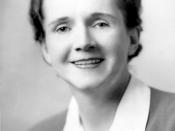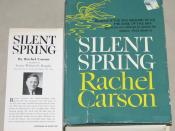How does the Rachel Carson use language to convey changes and contrasts in mood and meaning in Silent Spring? The mood in the extracts from Rachel Carson's Silent Spring changes continually from beginning to end. The first paragraph has an almost fairy-tale feeling to it - the tone is pleasant and calm and the opening, "There was once a townâ¦" is quite similar to that you'd find in a child's story book. The chapter title, "A Fable for Tomorrow" also reinforces this story-like sentiment. This is supported by the dreamy imagery Carson uses; she talks of mists and snow, and describes the spring blooms as "white clouds". Carson describes various natural elements of this town, rather than it's architecture or it's inhabitants, and does so using long, flowing sentences echoing the soft, undulating landscapes she is talking about. Even the words she uses are generally soft-sounding, which reflect this harmonious tone.
However, in the second paragraph, the tone changes quite dramatically. The first thing I noticed was that the sentences are much shorter and the words are much blunter and have a sharper sound, e.g. sickness, stricken - creating quite an angry temperament. When looking more closely at the words Carson used, I recognise that more than once she used words to depict puzzlement and uncertainty. For example, she described the disease affecting the livestock as mysterious, and wrote that deaths were "sudden and unexplainedâ¦", leaving the townspeople "puzzled and disturbed." These descriptions, coupled with the original term, "Some evil spellâ¦" change the tone from gentle, to bitter and unpleasant whilst reflecting the story-like qualities from the first paragraph. The unexplainable aspect described also creates a sense of vulnerability, but impacts more on the people living in the town, who weren't discussed in the first paragraph. Carson does also explain, quite fully, the way in which the birds had been affected, contrasting the once energetic sound of the dawn chorus with the silence and stillness that replaced it.
In the third paragraph we see Carson come out of the story-telling format so far used, and take over with her own personal narrative. The attitude is slightly calmer than that of the second paragraph, but also quite melancholy, endorsing the helpless feeling touched upon in paragraph two. The message she portrays is powerful, and thought provoking, and shows how the book might have been valuable in the environmental movement in the 1960's.
In conclusion, I think the changes Carson used were subtle, but very effective - the most valuable tool was changing the sentence structure. By switching from long, fluent sentences, full of imagery in the first paragraph, to much sharper and more compact sentences in the second , the reader can pick up on the changes in attitude almost without realising it.
BibliographyChambers, A and Northedge, A. (1997) The Arts Good Study Guide (Chapters 4 and 5), The Open UniversityExtracts from Chapter 1 A Fable for Tomorrow, of Silent Spring, Carson, R. 1962


